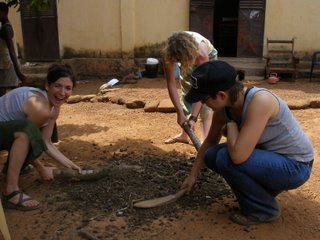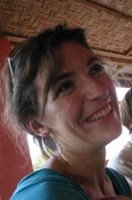Agronomy and Me

TEAK
During our first In-Service Training (IST) this July, Agroforestry volunteers complained earnestly to our trainers of a subtle, difficult-to-articulate, and arguably irrelevant feeling that we don’t know anything about agroforestry. “You’d be surprised how much that negatively impacts our work,” we explained.
“Let me just say one thing,” began our APCD, who is known, on the contrary, for saying many things without really saying much at all. “It is merely your unfounded sense of inadequacy, not your lack of knowledge, that causes you to think this.”
But as much as we might want him to be right, one plant stubbornly confirms our uselessness time and time again. That plant is Teak.
An expensive hard wood, whose seeds were easy to collect in Forecariah, it seemed a logical choice for a Reforestation Pepiniere. The 2006 Agfo Manual offered no pictures but assured it was a fast growing, sun-loving plant. Heady with optimism, I planted thirty, mercilessly stuck them outside the shade structure, and didn’t even pre-germinate them.
Weeks later a miniature forest had bloomed in my Pepiniere and still no sign of life among the “fast-growing” teak.
Big decisions had to be made. Squatting before the thirty sachets at dawn --before any groupement member could stop by and witness my deplorable ignorance—I uttered a solemn question to the Banfele morning: “Is that bizarre dandelion-looking-thing teak?” “No no,” I reasoned, “I see it growing in the Lengue sachets, too. There might even be a picture of it in the dictionary under ‘Weed’ .”
“What about that piece of grass there, is that teak? You know, rice looks like grass, but it’s not grass, it’s rice!” Leaning forward, I peer at it carefully. “No, no, it is not in the center. I planted all the tree seeds in the center of the sachets. Plus that plant is all over my lawn.”
Impatient, I finally size-up the lettucey-shrub busting ambiguously out of four of the teak sachets. “THAT doesn’t look like a tree,” I say derisively, glancing at the mango tree towering above my hut, which, by comparison, is undoubtedly more tree-like. “Impostor,” I mutter, glaring at the plant that unkindly evokes memories of Ceasar Salad.
Deflated, I weigh the options: leave the obnoxious little plants to grow, in the hopes that all the weeds will die and thirty trees will blossom in their stead, with the words, “I am a teak tree” scrawled on their bark—very plausible. But in the meantime, the groupement members will see my weedy Pepiniere and think I am negligent. Plus, its possible the teak won’t grow at all because I didn’t pre-germinate them, and I will be living in a constant state of anguished uncertainty for naught.
I voraciously rip out all the plants, pre-germinate another 30 teak seeds, and get to work watching them grow.
A few days later M. Kelema, Community Secretary and Agronomist, stops by. I smugly show him the progress among my other trees in the Pepiniere, careful not to boast because my work really speaks for itself; who ever dreamed of planting Guanaba in Banfele, and just look at them, defiantly robust and vivacious in the evening light. We approach the 30 replanted teak sachets.
“As you can see, the only plant that is under-performing is the teak. Really, a very challenging species to germinate. The other day, I pulled up the weeds, tried a new germination technique and replanted.”
Kelema bends down and surveys the planting. “That’s funny, ‘cause the last time I was here I saw some teak growing in there.”
My eyes widen. “Damn that lettuce-looking shrub. Trees are not supposed to look like that!” Several excuses flash through my mind to maintain credibility past month two of service. “Yes, of course, I just figured it would be best to start from scratch and regerminate them all.” Next time, Kelema is going to weed before I so much as look at the Pepiniere, I think. “Nice boubou, by the way, is that new?”
MANDIANA
“Compared to the rest of the world, Africa is behind. Compared to the rest of Africa, Guinea is behind. Compared to the rest of Guinea, Kouroussa is behind.”
Ever since MC—president of the Banfele Vacationers, and ardent advocate of reforestation or of courting white women (I’m still not sure)—pronounced these words in a speech to his Banfele fellow youths, I have wondered: Could Kouroussa (my prefecture), and not Mandiana—generally seen as the poorest and worst prefecture--be the actual armpit of Guinea?
Mandiana volunteers would fervently disagree. Mandiana, they say, is unequivocally the most unappealing prefecture of Guinea. Their upright candles “wilt” in the midday heat, their roads are impassable in the rainy season, in the dry season everything is brown, and once when they saw a banana in the market they nearly had a cow. Listening to Mandiana volunteers debate the virtues of corn verses cassava TO—something they do frequently and for hours—does much to substantiate their claims.
Still, I had my doubts, so I did a week-long tour of Mandiana. Vast rolling hills, green and picturesque against an expansive sky, belie the red gravelly earth that supports only a few species of sparsely planted trees. During the rainy season, Mandiana trees are submerged in a sea of elephant grasses that disappear for the rest of the year. Degraded land forces Mandiana farmers to cultivate fields an immense 40 Km from town, where they actually live for the duration of the rains.
Amid the characteristically highly centralized Malinke villages of Mandiana are a few that sprawl like midwestern towns. These are the settlements of the Wasaloo, the hunter-herdsman descendants of the Fouta Peuhls, who set out into the dessert after their leader feuded with a fouta King, then intermarried with the Malinkes and settled in Mandiana.
At first blush, you don’t quite get why they are so proud of their Peuhl last names; their marginal practice of Islam, fluency in Malinke, and lack of Pular makes them seem awfully Malinke. Still, they don’t dance quite as well, have very refined features, and live in sprawling uncentralized settlements like the Puehls they descend from.
Ultimately, you can’t help asking yourself what they’re doing there. The feuding brother of the Fouta king who said, “let’s leave this green fertile land to go eat TO and learn to drum”, was probably destined to perish in the desert…or spend a lifetime dreaming of legumes and feeling really stupid.
Nevertheless, Mandiana, I concluded, is in fact no armpit. It is, perhaps, some lesser sweat gland, an inner thigh maybe, a bit like New Jersey: disparaged by all but in reality only half as bad as Kansas. Compared to Kouroussa, Mandiana boasts a higher French level among its villagers, slightly better quality roads, more abundant water pumps, and what seemed to me like more widely practiced sustainable agricultural techniques (intercropping and live fencing). In sum, I fear chez moi, Kouroussa, is the legitimate armpit of Guinea.


1 Comments:
Well, didn't they tell you in the Peace Corps pamphlet that you'd require advanced agroforestry skills?! Sheesh! LOL
Post a Comment
<< Home